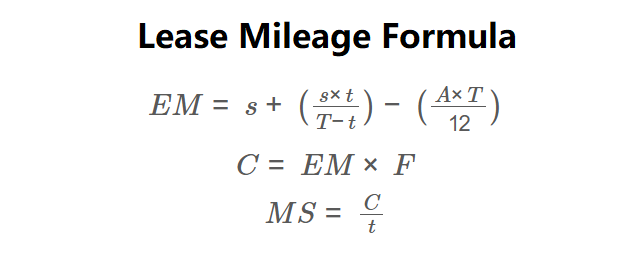1. What is the Lease Mileage Calculator?
Definition: The Lease Mileage Calculator estimates the number of miles you are likely to exceed on a car lease, the associated excess mileage charge, and the monthly savings required to cover the penalty, based on total lease term, remaining lease time, current miles driven, annual mileage allowance, and excess distance fee.
Purpose: This tool helps lessees assess potential overage fees due to exceeding mileage limits, enabling better budgeting and driving habit adjustments to avoid penalties.
2. How Does the Calculator Work?
The calculator uses the following formulas:
\( EM = s + \left( \frac{s \times t}{T - t} \right) - \left( \frac{A \times T}{12} \right) \)
\( C = EM \times F \)
\( MS = \frac{C}{t} \)
Where:
- \( EM \): Predicted excess miles;
- \( s \): Current miles driven;
- \( t \): Remaining lease time (months);
- \( T \): Total lease term (months);
- \( A \): Annual mileage allowance;
- \( F \): Excess distance fee ($/mile);
- \( C \): Predicted lease-end charge ($);
- \( MS \): Monthly savings required ($).
Steps:
- Enter total lease term, remaining lease time, current miles driven, annual mileage allowance, and excess distance fee.
- Calculate predicted excess miles using the formula above.
- Calculate lease-end charge: multiply excess miles by the fee per mile.
- Calculate monthly savings required: divide the lease-end charge by remaining months.
- Display results in integer (miles) and currency formats.
3. Importance of Lease Mileage Calculation
Calculating lease mileage is essential for:
- Cost Management: Estimates potential excess mileage charges, which can range from $0.10 to $0.30 per mile, helping avoid unexpected fees at lease-end.
- Driving Habit Adjustment: Encourages monitoring and adjusting driving to stay within mileage limits, reducing financial penalties.
- Budget Planning: Determines monthly savings needed to cover potential charges, aiding in financial preparation.
4. Using the Calculator
Example: Calculate the excess mileage for a 24-month lease with 6 months remaining, 15,000 miles driven, an 8,000-mile annual allowance, and a $0.20 per mile excess fee:
- Total Lease Term (\( T \)): 24 months;
- Remaining Lease Time (\( t \)): 6 months;
- Current Miles Driven (\( s \)): 15,000;
- Annual Mileage Allowance (\( A \)): 8,000;
- Excess Distance Fee (\( F \)): $0.20/mile;
- Excess Miles (\( EM \)): \( 15000 + \left( \frac{15000 \times 6}{24 - 6} \right) - \left( \frac{8000 \times 24}{12} \right) = 15000 + 5000 - 16000 = 4000 \);
- Lease-End Charge (\( C \)): \( 4000 \times 0.20 = 800 \);
- Monthly Savings (\( MS \)): \( \frac{800}{6} \approx 133.33 \);
- Result: Predicted Excess Miles: 4,000; Predicted Lease-End Charge: $800.00; Monthly Savings Required: $133.33.
5. Frequently Asked Questions (FAQ)
Q: What are excess mileage charges?
A: Fees charged by leasing companies for miles driven beyond the agreed annual mileage allowance, typically $0.10-$0.30 per mile, to cover vehicle depreciation.
Q: How can I avoid excess mileage charges?
A: Monitor mileage regularly, adjust driving habits, negotiate a higher mileage allowance upfront, or buy the vehicle at lease-end to avoid penalties.
Q: Why is the monthly savings required useful?
A: It helps plan monthly budgets to cover potential lease-end charges, ensuring financial preparedness if excess miles are unavoidable.
Lease Mileage Calculator© - All Rights Reserved 2025
 Home
Home
 Back
Back
